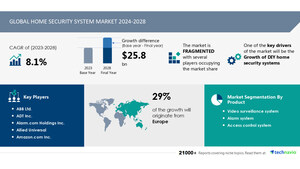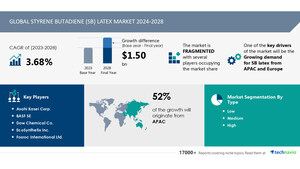NEW YORK, March 21, 2024 /PRNewswire/ -- The iron drugs market is set to experience substantial growth between 2023 and 2027, with an estimated increase of USD 3,552.86 million. This growth, projected at a CAGR of 9.41%, reflects a burgeoning demand driven by multiple factors including the increasing prevalence of iron deficiency worldwide, growing awareness regarding the critical role of iron in maintaining overall health, and the expanding geriatric population.
To understand more about this market- Download The Sample Report
Iron deficiency, a widespread concern affecting individuals across all age groups and genders, particularly adolescent girls, has emerged as a key driver propelling market expansion. This deficiency, attributed to various factors such as inadequate iron intake, increased demand during growth phases, menstrual blood loss, and certain medical conditions, underscores the crucial need for effective iron supplementation.
In response to this demand, the market has witnessed significant trends, notably the proliferation of Chronic Kidney Disease (CKD) dialysis centers in emerging economies. Countries like China, India, and Brazil are witnessing a surge in CKD cases, prompting renal anemia therapeutics vendors to invest in these regions. This trend has led to an increase in the number of dialysis centers, creating new growth opportunities for market players.
To understand more about this market- Download The Sample Report
However, despite these positive developments, the market faces challenges, notably the high cost of Intravenous (IV) iron therapies. While IV therapies offer several advantages over oral supplements, their relatively higher cost poses a hurdle to widespread adoption. The substantial initial investment, coupled with significant out-of-pocket expenses, may deter individuals from opting for these treatments, impacting market growth.
In light of these dynamics, companies in the iron drugs market are strategically positioning themselves to capitalize on emerging opportunities. Industry leaders like AbbVie Inc. are leveraging research and development efforts to innovate and offer effective iron drugs such as Infed Iron Dextran Injection, aiming to address unmet medical needs and drive market penetration.
To understand more about this market- Download The Sample Report
Furthermore, the market landscape is characterized by a diverse array of players, including Abbott Laboratories, GlaxoSmithKline Plc, and Sanofi SA, among others. These companies are adopting various strategies such as strategic alliances, geographical expansion, and product launches to strengthen their market presence and cater to evolving consumer needs.
The oral drug segment is anticipated to emerge as the fastest-growing segment during the forecast period, fueled by the availability of over-the-counter supplements and their generally favorable tolerability among patients. Ferrous sulfate, ferrous gluconate, and ferrous fumarate are among the commonly used oral iron supplements, catering to the increasing demand for iron supplementation.
To understand more about this market- Download The Sample Report
Geographically, North America is expected to contribute significantly to market growth, driven by the high prevalence of anemia, particularly among the elderly population and women experiencing heavy menstrual bleeding or pregnancy. Government initiatives aimed at increasing awareness of conditions like CKD are poised to further bolster regional market growth.
In summary, the iron drugs market is witnessing robust growth propelled by factors such as rising prevalence of chronic diseases, increasing awareness, and technological advancements. While challenges such as high treatment costs persist, market players are poised to capitalize on emerging opportunities and drive innovation to meet evolving consumer needs.
To understand more about this market- Download The Sample Report
Analyst Review
In a rapidly evolving healthcare landscape, the global market for intravenous (IV) and oral iron drugs is experiencing unprecedented growth. This surge is attributed to an array of factors including rising incidences of chronic diseases such as cancer, chronic kidney disease (CKD), inflammatory bowel disease (IBD), and anemia, among others.
The Global Cancer Observatory's data underscores the critical role of iron supplementation in managing cancer-related anemia, particularly prevalent in patients undergoing chemotherapy. Furthermore, in the realm of chronic diseases like CKD and IBD, where gastrointestinal adverse effects are commonplace, iron drugs play a pivotal role in replenishing iron levels while mitigating such complications.
Pharmaceutical innovations, coupled with FDA approvals, have propelled the market forward. Notable products such as Injectafer, Ferinject, Iron isomaltoside, and Ferric carboxymaltose are gaining traction globally. The recent introduction of Ferric derisomaltose injection by Pharmacosmos Therapeutics Inc signals a significant advancement in addressing iron deficiency anemia (IDA) associated with chronic heart failure and kidney dialysis.
Teleconsultations and telemedicine have facilitated the accessibility of iron drugs, especially in remote areas, ensuring patients receive timely interventions. Moreover, collaborations and partnerships between pharmaceutical companies like Pharmacosmos A/S and healthcare providers are fostering innovation and widening the reach of iron therapies.
In addition to IV formulations, oral iron drugs remain pivotal in managing conditions like celiac disease, where gastrointestinal absorption is impaired. The market is witnessing product launches such as MonoVer, catering to the diverse needs of patients suffering from iron deficiency disorders.
While addressing prevalent diseases like malaria, HIV/AIDS, tuberculosis (TB), and pneumonia is crucial, it's imperative not to overlook the underlying issue of iron deficiency, which exacerbates these conditions. Awareness campaigns focusing on the importance of iron supplementation in infectious diseases are gaining momentum.
As we navigate through the complexities of modern healthcare, the iron drugs market continues to evolve, offering hope and improved quality of life to millions worldwide. With advancements in research, development, and accessibility, the future holds promise for further breakthroughs in iron therapies, ultimately enhancing global health outcomes.
To understand more about this market- Download The Sample Report
Market Overview
Innovations in the global intravenous iron drugs market are set to revolutionize treatments for a spectrum of conditions. From combating inflammatory bowel disease and infectious diseases to addressing malaria, HIV/AIDS, hepatitis, pneumonia, and influenza, these advancements signify a pivotal moment in healthcare. The market's expansion is fueled by a surge in demand for both IV and oral drugs, offering patients versatile and effective treatment options. Leveraging insights from the Global Cancer Observatory, stakeholders are poised to make significant strides in enhancing patient outcomes and quality of life worldwide. As the market continues to evolve, collaborations between pharmaceutical companies and healthcare providers promise groundbreaking solutions for the most pressing medical challenges.
To understand more about this market- Download The Sample Report
Related Reports
The oncology drugs market size is estimated to grow at a CAGR of 11.99% between 2023 and 2027. The market size is forecast to increase by USD 151.84 billion. Furthermore, this report extensively covers market segmentation by therapy (targeted therapy, immunotherapy, hormonal therapy, and chemotherapy), distribution channel (offline and online), and geography (North America, Europe, Asia, and the Rest of the World (ROW)). The Increasing prevalence of cancer is a key factor driving the market growth during the forecast period.
The acne drugs market size is estimated to grow at a CAGR of 3.46% between 2022 and 2027. The acne drugs market size is forecast to increase by USD 907.11 million. Furthermore, this report extensively covers market segmentation by type (prescription drugs and OTC drugs), route of administration (topical and oral), and geography (North America, Europe, Asia, and the Rest of the World). The emergence of improved diagnostic modalities is a key factor driving the market growth during the forecast period.
Table of Contents
1 Executive Summary
2 Landscape
3 Sizing
4 Historic Size
5 Five Forces Analysis
6 Segmentations
7 Customer Landscape
8 Geographic Landscape
9 Drivers, Challenges, and Trends
10 Vendor Landscape
11 Vendor Analysis
12 Appendix
About US
Technavio is a leading global technology research and advisory company. Their research and analysis focuses on emerging market trends and provide actionable insights to help businesses identify market opportunities and develop effective strategies to optimize their market positions. With over 500 specialized analysts, Technavio's report library consists of more than 17,000 reports and counting, covering 800 technologies, spanning 50 countries. Their client base consists of enterprises of all sizes, including more than 100 Fortune 500 companies. This growing client base relies on Technavio's comprehensive coverage, extensive research, and actionable market insights to identify opportunities in existing and potential markets and assess their competitive positions within changing market scenarios.
Contact
Technavio Research
Jesse Maida
Media & Marketing Executive
US: +1 844 364 1100
UK: +44 203 893 3200
Email: [email protected]
Website: www.technavio.com
SOURCE Technavio

WANT YOUR COMPANY'S NEWS FEATURED ON PRNEWSWIRE.COM?
Newsrooms &
Influencers
Digital Media
Outlets
Journalists
Opted In





Share this article